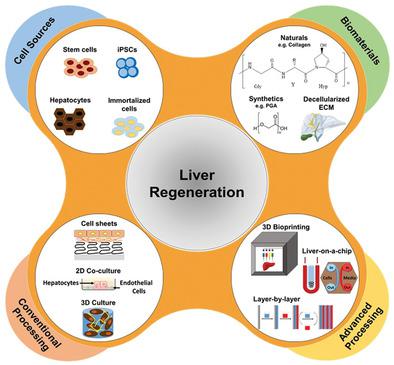当前位置:
X-MOL 学术
›
Adv. Healthcare Mater.
›
论文详情
Our official English website, www.x-mol.net, welcomes your
feedback! (Note: you will need to create a separate account there.)
Advanced Biomaterials and Processing Methods for Liver Regeneration: State-of-the-Art and Future Trends.
Advanced Healthcare Materials ( IF 10.0 ) Pub Date : 2020-01-24 , DOI: 10.1002/adhm.201901435 Alain da Silva Morais 1, 2 , Sílvia Vieira 1, 2 , Xinlian Zhao 3 , Zhengwei Mao 3 , Changyou Gao 3 , Joaquim M Oliveira 1, 2, 4 , Rui L Reis 1, 2, 4
Advanced Healthcare Materials ( IF 10.0 ) Pub Date : 2020-01-24 , DOI: 10.1002/adhm.201901435 Alain da Silva Morais 1, 2 , Sílvia Vieira 1, 2 , Xinlian Zhao 3 , Zhengwei Mao 3 , Changyou Gao 3 , Joaquim M Oliveira 1, 2, 4 , Rui L Reis 1, 2, 4
Affiliation

|
Liver diseases contribute markedly to the global burden of mortality and disease. The limited organ disposal for orthotopic liver transplantation results in a continuing need for alternative strategies. Over the past years, important progress has been made in the field of tissue engineering (TE). Many of the early trials to improve the development of an engineered tissue construct are based on seeding cells onto biomaterial scaffolds. Nowadays, several TE approaches have been developed and are applied to one vital organ: the liver. Essential elements must be considered in liver TE-cells and culturing systems, bioactive agents or growth factors (GF), and biomaterials and processing methods. The potential of hepatocytes, mesenchymal stem cells, and others as cell sources is demonstrated. They need engineered biomaterial-based scaffolds with perfect biocompatibility and bioactivity to support cell proliferation and hepatic differentiation as well as allowing extracellular matrix deposition and vascularization. Moreover, they require a microenvironment provided using conventional or advanced processing technologies in order to supply oxygen, nutrients, and GF. Herein the biomaterials and the conventional and advanced processing technologies, including cell-sheets process, 3D bioprinting, and microfluidic systems, as well as the future trends in these major fields are discussed.
中文翻译:

先进的肝脏再生生物材料和加工方法:最新技术和未来趋势。
肝病显着加剧了全球性的死亡和疾病负担。原位肝移植器官处理的局限性导致对替代策略的持续需求。在过去的几年中,在组织工程学(TE)领域取得了重要进展。许多改善工程组织构造发展的早期试验都是基于将细胞播种到生物材料支架上的。如今,已开发出多种TE方法并将其应用于一个重要器官:肝脏。肝TE细胞和培养系统,生物活性剂或生长因子(GF)以及生物材料和加工方法中必须考虑基本元素。证明了肝细胞,间充质干细胞和其他作为细胞来源的潜力。他们需要具有生物相容性和生物活性的工程生物材料支架,以支持细胞增殖和肝分化,并允许细胞外基质沉积和血管形成。而且,它们需要使用常规或先进的加工技术提供的微环境,以供应氧气,营养物和GF。本文讨论了生物材料以及包括细胞片工艺,3D生物打印和微流体系统在内的常规和先进的加工技术,以及这些主要领域的未来趋势。他们需要使用常规或先进的加工技术提供的微环境,以供应氧气,营养物和GF。本文讨论了生物材料以及包括细胞片工艺,3D生物打印和微流体系统在内的常规和先进的加工技术,以及这些主要领域的未来趋势。他们需要使用常规或先进的加工技术提供的微环境,以供应氧气,营养物和GF。本文讨论了生物材料以及包括细胞片工艺,3D生物打印和微流体系统在内的常规和先进的加工技术,以及这些主要领域的未来趋势。
更新日期:2020-03-04
中文翻译:

先进的肝脏再生生物材料和加工方法:最新技术和未来趋势。
肝病显着加剧了全球性的死亡和疾病负担。原位肝移植器官处理的局限性导致对替代策略的持续需求。在过去的几年中,在组织工程学(TE)领域取得了重要进展。许多改善工程组织构造发展的早期试验都是基于将细胞播种到生物材料支架上的。如今,已开发出多种TE方法并将其应用于一个重要器官:肝脏。肝TE细胞和培养系统,生物活性剂或生长因子(GF)以及生物材料和加工方法中必须考虑基本元素。证明了肝细胞,间充质干细胞和其他作为细胞来源的潜力。他们需要具有生物相容性和生物活性的工程生物材料支架,以支持细胞增殖和肝分化,并允许细胞外基质沉积和血管形成。而且,它们需要使用常规或先进的加工技术提供的微环境,以供应氧气,营养物和GF。本文讨论了生物材料以及包括细胞片工艺,3D生物打印和微流体系统在内的常规和先进的加工技术,以及这些主要领域的未来趋势。他们需要使用常规或先进的加工技术提供的微环境,以供应氧气,营养物和GF。本文讨论了生物材料以及包括细胞片工艺,3D生物打印和微流体系统在内的常规和先进的加工技术,以及这些主要领域的未来趋势。他们需要使用常规或先进的加工技术提供的微环境,以供应氧气,营养物和GF。本文讨论了生物材料以及包括细胞片工艺,3D生物打印和微流体系统在内的常规和先进的加工技术,以及这些主要领域的未来趋势。











































 京公网安备 11010802027423号
京公网安备 11010802027423号